ISW for the Treatment of Angle Class II Division 1 Combined with Unstable Mandibular Position
Kuo Li-Ling1, Yu Chien-Chih2, Wu Wei-Te3, Yu Jian-Hong1*
1Department of Orthodontics, China Medical University Hospital, Taichung City, Taiwan
2School of Pharmacy, College of Pharmacy, China Medical University, Taichung, Taiwan
3Department of Biomechatronics Engineering, National Pingtung University of Science and Technology, Pingtung County, Taiwan
*Corresponding Authors: Yu Jian-Hong, Department of Orthodontics, China Medical University Hospital, No. 2, Yude Road, North District, Taichung City 404, Taiwan, R.O.C.
Received: 01 April 2020; Accepted: 09 April 2020; Published: 21 April 2020
Article Information
Citation:
Kuo Li-Ling, Yu Chien-Chih, Wu Wei-Te, Yu Jian-Hong. ISW for the Treatment of Angle Class II Division 1 Combined with Unstable Mandibular Position. Dental Research and Oral Health 3 (2020): 035-051.
View / Download Pdf Share at FacebookAbstract
Introduction: This article presents a case of Angle Class II division 1 with completed treatment. We used improved super-elastic Ti–Ni alloy wire (ISW) and the modified multiloop edgewise arch wire (MEAW) technique to create space and to relieve anterior and posterior crowding in an adult female patient with poor dental alignment and facial asymmetry. Intermaxillary elastics were also used to improve the mandibular position and intercuspal interdigitation. The patient was treated by crowding relief, facial asymmetry correction, the MEAW technique, and overjet reduction.
Findings: The patient was treated successfully using ISW.
Conclusion: In this case, we rapidly corrected poor dental alignment by using ISW and the MEAW technique. Compared with conventional stainless steel wire treatment, ISW provides an efficient and easy approach to correct such malocclusion. Successful treatment outcomes were attained, and the patient was pleased with the treatment results.
Keywords
Angle Class II division 1, Facial asymmetry, ISW, MEAW
Angle Class II division 1 articles, Facial asymmetry articles, ISW articles, MEAW articles
Angle Class II division 1 articles Angle Class II division 1 Research articles Angle Class II division 1 review articles Angle Class II division 1 PubMed articles Angle Class II division 1 PubMed Central articles Angle Class II division 1 2023 articles Angle Class II division 1 2024 articles Angle Class II division 1 Scopus articles Angle Class II division 1 impact factor journals Angle Class II division 1 Scopus journals Angle Class II division 1 PubMed journals Angle Class II division 1 medical journals Angle Class II division 1 free journals Angle Class II division 1 best journals Angle Class II division 1 top journals Angle Class II division 1 free medical journals Angle Class II division 1 famous journals Angle Class II division 1 Google Scholar indexed journals Facial asymmetry articles Facial asymmetry Research articles Facial asymmetry review articles Facial asymmetry PubMed articles Facial asymmetry PubMed Central articles Facial asymmetry 2023 articles Facial asymmetry 2024 articles Facial asymmetry Scopus articles Facial asymmetry impact factor journals Facial asymmetry Scopus journals Facial asymmetry PubMed journals Facial asymmetry medical journals Facial asymmetry free journals Facial asymmetry best journals Facial asymmetry top journals Facial asymmetry free medical journals Facial asymmetry famous journals Facial asymmetry Google Scholar indexed journals ISW articles ISW Research articles ISW review articles ISW PubMed articles ISW PubMed Central articles ISW 2023 articles ISW 2024 articles ISW Scopus articles ISW impact factor journals ISW Scopus journals ISW PubMed journals ISW medical journals ISW free journals ISW best journals ISW top journals ISW free medical journals ISW famous journals ISW Google Scholar indexed journals MEAW articles MEAW Research articles MEAW review articles MEAW PubMed articles MEAW PubMed Central articles MEAW 2023 articles MEAW 2024 articles MEAW Scopus articles MEAW impact factor journals MEAW Scopus journals MEAW PubMed journals MEAW medical journals MEAW free journals MEAW best journals MEAW top journals MEAW free medical journals MEAW famous journals MEAW Google Scholar indexed journals mandibular articles mandibular Research articles mandibular review articles mandibular PubMed articles mandibular PubMed Central articles mandibular 2023 articles mandibular 2024 articles mandibular Scopus articles mandibular impact factor journals mandibular Scopus journals mandibular PubMed journals mandibular medical journals mandibular free journals mandibular best journals mandibular top journals mandibular free medical journals mandibular famous journals mandibular Google Scholar indexed journals orthodontic articles orthodontic Research articles orthodontic review articles orthodontic PubMed articles orthodontic PubMed Central articles orthodontic 2023 articles orthodontic 2024 articles orthodontic Scopus articles orthodontic impact factor journals orthodontic Scopus journals orthodontic PubMed journals orthodontic medical journals orthodontic free journals orthodontic best journals orthodontic top journals orthodontic free medical journals orthodontic famous journals orthodontic Google Scholar indexed journals canine articles canine Research articles canine review articles canine PubMed articles canine PubMed Central articles canine 2023 articles canine 2024 articles canine Scopus articles canine impact factor journals canine Scopus journals canine PubMed journals canine medical journals canine free journals canine best journals canine top journals canine free medical journals canine famous journals canine Google Scholar indexed journals intraoral articles intraoral Research articles intraoral review articles intraoral PubMed articles intraoral PubMed Central articles intraoral 2023 articles intraoral 2024 articles intraoral Scopus articles intraoral impact factor journals intraoral Scopus journals intraoral PubMed journals intraoral medical journals intraoral free journals intraoral best journals intraoral top journals intraoral free medical journals intraoral famous journals intraoral Google Scholar indexed journals
Article Details
1. Introduction
A 28-year-old woman visited our clinic with a chief complaint of poor dental alignment and facial asymmetry. Clinical examination revealed Angle Class II division 1. We used improved super-elastic Ti–Ni alloy wire (ISW) [1, 2] and the multiloop edgewise arch wire (MEAW) technique to create space and to relieve anterior and posterior crowding. Intermaxillary elastics (IME’s) were also used to achieve a more suitable mandibular position and intercuspal interdigitation. Finally, correction of arch coordination, space management, and bite control were achieved.
2. Case Report
This case report describes an adult female patient with poor dental alignment, facial asymmetry, and dental crossbite. The aforementioned problems were successfully treated using ISW and the MEAW technique.
3. Diagnosis and Etiology
A 28-year-old woman with a convex profile visited our clinic for an orthodontic consultation. The extraoral and frontal profile revealed adequate incisor exposure and an upper midline with no deviation from the facial midline (Figure 1). Clinical examination revealed Angle Class II division 1 and a lower right second premolar crossbite (Figure 2).
Panoramic radiography revealed the presence of #18, #28, and #48 wisdom teeth, an endodontically treated tooth (#47), and no unerupted teeth; however, signs of erosion were noted on the left mandibular condyle head (Figure 3). The cephalometric film indicated a skeletal Class II resulting from minor maxillary protrusion, a convex facial type (ANB: 6.1°), and a mandibular plane angle of 24.3°. Many parameters were not within ideal ranges. The posterior–anterior view revealed that the mandibular had shifted to the right. Clinical examination revealed no signs of bad habits (Figure 4, Figure 5 and Figure 6).

Figure 1: Pretreatment extraoral photos.

Figure 2: Pretreatment intraoral photos.

Figure 3: Pretreatment panoramic radiograph.

Figure 4: Pretreatment cephalometric radiograph with profilogram.

Figure 5: Pretreatment posterior–anterior radiograph.
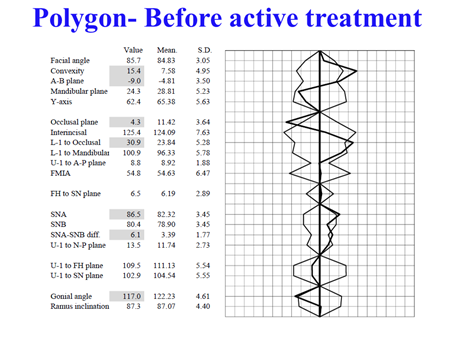
Figure 6: Pretreatment cephalometric polygon.
4. Treatment Objectives
The patient chiefly complained of poor dental alignment and facial asymmetry. The first priority was to address the chief complaint by achieving a molar Class I relationship and facial symmetry. Other objectives were to correct the crowding and the #45 crossbite, improve overjet and overbite, and obtain more suitable arch coordination and individual normal occlusion.
5. Treatment Plan
- #18, #28, and #48 extraction
- Full-mouth direct bonding system (DBS) and ISW leveling
- Observation of mandibular response [3].
- Use of the MEAW technique and IME’s for improved interdigitation and achievement of a molar Class I relationship.
6. Treatment Progress
After a detailed explanation and discussion, the patient agreed to receive the aforementioned orthodontic treatment. ISW (developed by Tokyo Medical and Dental University, Japan) has super-elastic, shape memory, and shock and vibration absorption properties. This paper describes the experience in treating a patient with Angle Class II division 1 using ISW combined with IME’s. This helped the patient gain an esthetically pleasing smile, with which she was satisfied. On November 28, 2016, we applied the DBS with 0.018 × 0.025-inch brackets over the upper and lower arches. We used a 0.016 × 0.022-inch ISW to level the teeth for 1 month; preliminary leveling and alignment were gradually achieved (Figure 7). On December 28, 2016, 1 month after commencing active treatment, the MEAW technique was used to correct the crossbite at #45. MEAW was applied in the lower right at #46 and #47, and an open coil spring was used between #43 and #45 to create a space for #44 (Figure 8). On March 27, 2017, 4 months of active treatment, the crossbite at #45 was corrected. Lower right MEAW at #45, #46, and #47 and lower left MEAW at #36 and #37 were placed. The lower anterior teeth flared out because MEAW was used without IME’s to reduce the overjet. An open coil spring was placed between #34 and #35 for midline correction (Figure 9).
On April 17, 2017, MEAW was placed in the upper posterior to achieve a molar Class I relationship. Class II IME was used for space creation to facilitate #12 and #22 derotation and to achieve an improved canine and molar relationship (R: #13–#45; L: #23–#35; Figure 10). On February 15, 2018, after 15 months of active treatment, #12 and #22 were appropriately positioned. To reduce the overjet, MEAW was placed in the upper posterior, and Class II IME was also used (R: #13–#45; L: #23–#35; Figure 11). On October 24, 2018, after 23 months of active treatment, a molar Class I relationship was achieved. IME’s were used to improve cusp interdigitation and the canine relationship (Figure 12).
7. Treatment Results
After 23 months of active treatment, extraoral and intraoral appearance was improved. A straight profile, lower facial height, and correlated facial midlines were achieved (Figure 13). Intraoral Class I canine and molar relationships were also achieved with favorable interdigitation, normal overbite and overjet, and suitable curve of Spee. The patient’s smile arc became more harmonious after treatment (Figure 13 and Figure 14). Post-treatment panoramic and cephalometric analyses (Figure 15, Figure 16 and Figure 17) and the superimposed cephalometric tracings (Figure 18 and Figure 19) demonstrated considerable improvement.
Pretreatment and post-treatment dental analyses revealed a change in the U1 to FH plane from 109.5° to 110.0° and a change in the L1 to mandibular plane from 100.9° to 115.0°; dental change were acceptable. At the end of the treatment, we provided the patient with a circumferential retainer for the upper arch, a Hawley retainer for the lower arch, and an auxiliary clear plastic retainer for retention [4]. The treatment outcome remained stable during several follow-up visits.

Figure 7: Start of active treatment involving upper and lower arch DBS and leveling with 0.016 × 0.022 ISW.
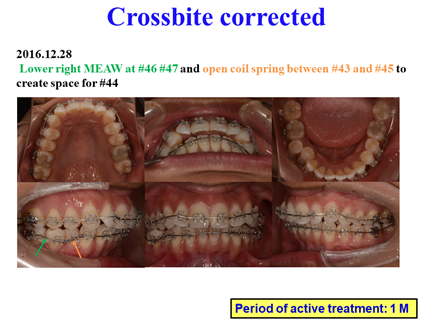
Figure 8: Lower right second premolar crossbite at #45 was corrected using fully-engaged ISW and MEAW.
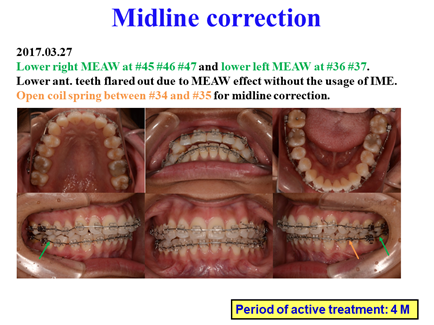
Figure 9: Lower midline correction.

Figure 10: Achievement of an Angle Class I molar relationship.

Figure 11: Reduction of the overjet.

Figure 12: Finishing and detailing.

Figure 13: Post-treatment extraoral photos.

Figure 14: Post-treatment intraoral photos.

Figure 15: Post-treatment panoramic radiograph.

Figure 16: Post-treatment cephalometric radiograph with profilogram.

Figure 17: Post-treatment cephalometric polygon.

Figure 18: Superimposition of lateral cephalometric tracings. Black line = before treatment and red line = after treatment.
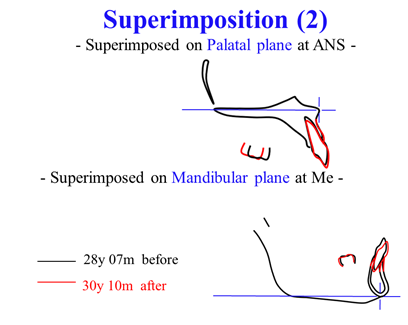
Figure 19: Maxillary and mandibular superimpositions.
t.
8. Discussion
We used MEAW and flare-out for crowding relief. Crowding relief was achieved through five procedures: extraction, stripping, expansion and flare-out, MEAW, and distalization. The MEAW technique allows the posterior teeth to tip back and intrude. With anterior teeth flaring out, a space was created, correcting the position of the crossbite tooth. Some problems also required our attention. The MEAW technique may increase the risk of posterior teeth disocclusion. Profile protrusion and interarch coordination are potential side effects when anterior teeth flare out (Figure 20). Chia et al. indicated that asymmetries have pathological, traumatic, functional, or developmental causes [5]. Haraguchi et al. revealed that the etiology of facial asymmetry can be grouped into hereditary factors of prenatal origin and acquired factors of postnatal origin [6]. In this case, the patient’s asymmetry likely resulted from #45 crossbite, which is a functional problem. In the P-A view, we observed that her mandible was corrected to the left at 2°. Following treatment, her facial appearance greatly improved. We observed no symptoms of left condyle erosion, and no signs of its deterioration were noted during the orthodontic process; this may contribute to an increasingly stable occlusion [7] (Figure 21).
The characteristics of ISW simplify the MEAW technique. Serial step-up and tip-back bends were performed using a heat bender. The dentition must first be prepared for the use of this mechanism by eliminating all rotations, spaces, crowding, or poorly positioned brackets [8]. By using the MEAW technique, uprighting, distal tipping, and even relative intrusion for tooth control can be performed. In this case, we used the MEAW technique with IME to improve the molar and canine relationship. We also used the MEAW technique without IME to flatten the curve of Spee. The tip-back degree of the lower first molar changed from 86° to 77° (9° of difference). The tip-back degree of the upper first molar changed from 82° to 72° (10° of difference; Figure 22). Overjet is measured from the labial surface of the most prominent incisor to the labial surface of the mandibular incisor; the distance is typically 2.0~4.0 mm (0.079~0.157 in). If the lower incisor is anterior to the upper incisor, the overjet is given a negative value [9]. In this case, we wanted to achieve a more favorable overjet; therefore, overjet reduction was necessary. First, we used the MEAW technique without IME to allow the lower anterior teeth to flare out. Thus, the overjet was reduced from 6.0 to 3.5 mm within 14 months. Then, MEAW was placed on the upper posterior teeth with IME. The overjet decreased as a result of upper anterior teeth retraction and mandible protraction. The overjet decreased from 3.5 to 3.0 mm within 8 months. IME’s were also used to improve the mandibular position and intercuspal interdigitation [10, 11] (Figure 23).
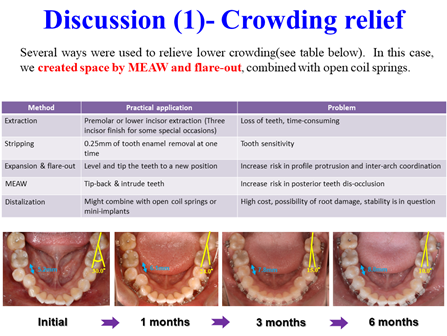
Figure 20: Crowding relief.

Figure 21: Facial asymmetry correction.

Figure 22: MEAW.

Figure 23: Overjet reduction.
9. Summary and Conclusions
We rapidly corrected poor dental alignment by using ISW and the MEAW technique. Compared with conventional treatment with stainless steel wire, ISW provides an efficient and easy approach to correct such malocclusion. Successful treatment outcomes were obtained, and the patient was pleased with the results.
Acknowledgement
This work was supported by China Medical University and Hospital, Taichung City, Taiwan (Grant number: CMU105-S-30). This manuscript was edited by Wallace Academic Editing. No specific funding was received for this report.
Availability of Data and Materials
The materials are available upon request.
Authors’ Contributions
YJH was responsible for treatment planning. YJH was responsible for clinical patient treatment. KLL, YCC, WWT, and YJH drafted the manuscript. All authors read and approved the final manuscript.
Ethics Approval and Consent to Participate
The procedures performed in this study were in accordance with the wishes of Ms. Ko. This case report and the treatment plan were approved by the chairman of the Department of Orthodontics, China Medical University.
Consent for Publication
Written informed consent was obtained from the patient for publication of this short report and any accompanying images.
Conflict of Interest
The authors declare that they have no competing interests.
References
- Miura F, Mogi M, Ohura Y, et al. The Superelastic Property of the Japanese NiTi Alloy Wire for Use in Orthodontics. American Journal of Orthodontics and Dentofacial Orthopedics 90 (1986): 1-10.
- Lai WJ, Midorikawa Y, Kanno Z, et al. A New Orthodontic Force System for Moment Control Utilizing the Flexibility of Common Wires: Evaluation of the Effect of Contractile Force and Hook Length. Journal of the Formosan Medical Association 117 (2018): 71-79.
- Singh S, Shivaprakash G. To Evaluate the Correlation Between Skeletal and Dental Parameters to the Amount of Crowding in Class II Div. 1 Malocclusions. Journal of Clinical and Diagnostic Research 11 (2017): ZC22-ZC27.
- Zachrisson BU. Important Aspects of Long-term Stability. American Journal of Orthodontics and Dentofacial Orthopedics 112 (1997): 596-606.
- Chia MS, Naini FB, Gill DS. The Aetiology, Diagnosis and Management of Mandibular Asymmetry. Orthodontic Update 1 (2008): 44-52.
- Haraguchi S, Takada K, Yasuda Y. Facial Asymmetry in Subjects with Skeletal Class III Deformity. The Angle Orthodontist 72 (2002): 28-35.
- Tanaka E, Kikuchi K, Sasaki A, et al. An Adult Case of TMJ Osteoarthrosis Treated with Splint Therapy and the Subsequent Orthodontic Occlusal Reconstruction: Adaptive Change of the Condyle During the Treatment. American Journal of Orthodontics and Dentofacial Orthopedics 118 (2000): 566-571.
- Kim YH, Han UK. The Versatility and Effectiveness of the Multiloop Edgewise Archwire (MEAW) in Treatment of Various Malocclusions. World Journal of Orthodontics 2 (2001): 208-218.
- Mitchell L. An Introduction to Orthodontics. 4th ed. Oxford: Oxford University Press (2013).
- Candice MS, Chaconas SJ, Caputo AA. Effects of Intermaxillary Elastic Traction on Orthodontic Tooth Movement. Journal of Rehabilitation 5 (1978): 159-166.
- Bishara SE, Chadha JM, Potter RB. Stability of Intercanine Width, Overbite, and Overjet Correction. American Journal of Orthodontics and Dentofacial Orthopedics 63 (1973): 588-595.


 Impact Factor: * 3.1
Impact Factor: * 3.1 Acceptance Rate: 76.66%
Acceptance Rate: 76.66%  Time to first decision: 10.4 days
Time to first decision: 10.4 days  Time from article received to acceptance: 2-3 weeks
Time from article received to acceptance: 2-3 weeks 